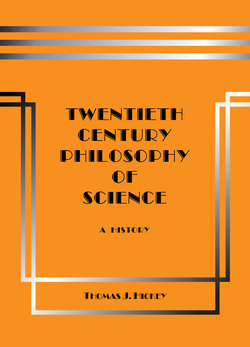Читать книгу Twentieth-Century Philosophy of Science: A History (Third Edition) - Thomas J. Hickey - Страница 48
На сайте Литреса книга снята с продажи.
3.17 Pragmatist Semantics Illustrated
ОглавлениеConsider the following analogy illustrating relativized semantics. Our linguistic system is analogous to a mathematical simultaneous-equation system. The equations of the system are a constraining context that determines the variables’ numerical values constituting a solution set for the equation system. If there is not a sufficient number of constraining equations, the system is underdetermined such that there are an indefinitely large number of possible numerical solution sets.
In pure mathematics numerical underdetermination can be eliminated and the system can be made uniquely determinate by adding related independent equations, so there are just as many equations as there are variables. Then there is one uniquely determined solution set of numerical values for the equation system.
When applying such a mathematically uniquely determined equation system to reality as in basic science or in engineering, the pure mathematics functions as the syntax for a descriptive language, when the numerical values of the descriptive variables are measurements. But the measurement values make the mathematically uniquely determined equation system empirically underdetermined due to measurement errors, which can be reduced indefinitely but never completely eliminated. Then even for a mathematically uniquely determined equation system admitting only one solution set of numerical values, there is still an infinitely large number of possible measurement values falling within even a narrow range of empirical underdetermination due to measurement errors.
When the simultaneous system of equations expresses an empirical theory in a test, and if its solution-set numerical values fall within the estimated range of measurement error in the corresponding measurement values produced in the test, then the theory is deemed not falsified. But if the solution-set numerical values are outside the estimated range of measurement error in the measurement values, then the theory is deemed to have been falsified by all who accept the test design and its execution.
The language system is like a mathematically underdetermined equation system having an infinitely large number of solution sets for the system. A set of logically consistent beliefs constituting a system of universally quantified related statements is a constraining context that determines the semantics of the descriptive terms in the belief system. This is most evident in an axiomatized deductive system. Like the equation system’s numerical values the language system’s semantics for any “semantical solution set”, as it were, are relativized to one another by the system’s universal beliefs and have definitional force. But the semantics conceptualizing sense stimuli always contains some vagueness. Due to this vagueness the linguistic system is empirically underdetermined and admits to an indefinitely large number of relativized semantical sets for the system. There is no uniquely determinate belief system of concepts.
This vagueness does not routinely manifest itself or cause communication problems so long as we encounter expected or familiar experiences for which our conventionalized beliefs are prepared. But the language user may on occasion encounter a new situation, for which the existing relevant conventional beliefs cannot take into account. In such new situations the language user must make some decisions about the applicability of one or several of the problematic terms in their existing beliefs, and then add some new beliefs or reject some currently accepted beliefs, if the decision about applicability is not simply ad hoc.
Adding more universally quantified statements to the belief system reduces this empirical underdetermination by adding clarifying information, but the residual vagueness can never be completely eliminated. Our semantics captures determinate mind-independent reality, but the cognitive capture with our semantics can never be exhaustive. There is always residual vagueness in our semantics. Vagueness and measurement error are both manifestations of empirical underdetermination. And increased clarity reduces vagueness as increased accuracy reduces measurement error.
Relativized semantics also has implications for ontology. Mind-independent recalcitrant reality imposes the empirical constraint that makes our belief systems contingent, and in due course falsifies them. Our access to mind-independent reality is by language-dependent relativized semantics, which signifies a corresponding ontology. Ontology is the cognitively apprehended aspects of the fathomless plenitude that is mind-independent reality as described by the relativized semantics. Thus there are no referentially absolute or fixed terms. Instead descriptive terms are always fuzzy, i.e., referentially indeterminate or as Quine says “inscrutable”, because their semantics is always empirically underdetermined.
Three noteworthy consequences of the artifactual thesis of relativized semantics are:
-Rejection of the positivist observation-theory dichotomy,
-Rejection of the positivist thesis of meaning invariance.
-Rejection of the positivist analytic-synthetic dichotomy.
